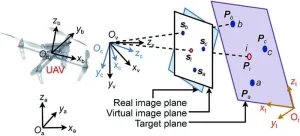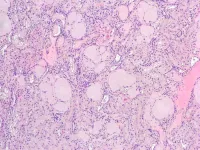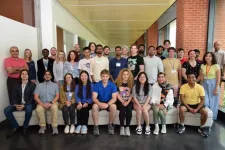(Press-News.org) The US has committed to reaching net-zero emissions by 2050. To accomplish this goal, large cuts in emissions are necessary, especially in high-emission sectors like the building industry. In an article publishing on August 18 in the journal One Earth, a team of researchers use a computational model to analyze several scenarios of future building energy use in the US. They find that by tackling emissions on multiple fronts and placing focus on “demand-side measures” that affect how power is drawn from the grid, such as technologies like electric heat pumps and smart thermostats, the US can achieve its climate goals, decrease building emissions by 91% from their 2005 peak, and save over $100 billion each year on energy costs.
“Meeting the US 2050 net-zero emissions target requires a rapid and cost-effective low-carbon transition across the entire energy system,” writes the team of energy technology experts based at Lawrence Berkeley National Laboratory and energy consultants. “Commercial and residential buildings are a primary source of emissions and are key to this transition.”
In the United States, the authors cite, buildings—including both public buildings, like offices, and private buildings, like homes—contribute 35% of the country’s total greenhouse gas emissions. In 2005, the US contributed 2,327 megatons of carbon dioxide in the buildings sector, setting a record for all-time high emissions. Since then, emissions have declined by 25%, and are projected to keep declining by up to another 41% by 2050. But we will need to keep cutting emissions to reach our climate goals, assert the authors.
For their analysis, the authorship team defines three main ways to cut building-related emissions. They argue that we should focus on making buildings use energy more efficiently, making the power grid more reliable by increasing the flexibility of how energy is managed by the grid, and utilizing low-carbon energy sources. “There are no ‘silver bullet’ solutions for building decarbonization,” write the authors. “Achieving deeper levels of emissions reductions will require a comprehensive mix of solutions addressing both the generation and end uses of energy—a true ‘all-of-the-above’ menu of solutions to decarbonize the built environment.”
The team modeled “low,” “moderate,” and “aggressive” scenarios of this “all-of-the-above menu” to determine the degree to which we can cut emissions. They found that it’s possible to reduce building emissions by 91% compared to 2005 levels by 2050, and that demand-side measures that increase the flexibility of the power grid, like heat pumps and smart thermostats, could contribute up to 45% of these emissions cuts.
“Flexibility will play an increasingly important role as variable renewable energy accounts for a larger share of power generation and distribution networks are challenged by growing demand for clean electricity,” write the researchers.
However, achieving this level of emissions cuts would require the “aggressive” level of intervention from the researchers’ model, and the authors emphasize that an “unprecedented scale and speed of building technology development and deployment” would be necessary, as well as a largescale commitment to changing how we consume energy.
“Realizing this level of change in the building sector will require a rapid and sustained increase in investment alongside policy and regulatory support,” write the authors. “We hope that this study can inform concrete policy approaches that accelerate energy system decarbonization across both demand- and supply-side technologies to fulfill ambitious targets for climate change mitigation in the US.”
###
This research was supported by funding from the US Department of Energy Office of Energy Efficiency and the Renewable Energy Building Technologies Office.
One Earth, Langevin et al. “Demand-side solutions in the US building sector could achieve deep emissions reductions while avoiding over $100 billion in power sector decarbonization costs.” https://www.cell.com/one-earth/fulltext/S2590-3322(23)00342-1
One Earth (@OneEarth_CP), published by Cell Press, is a monthly journal that features papers from the fields of natural, social, and applied sciences. One Earth is the home for high-quality research that seeks to understand and address today’s environmental Grand Challenges, publishing across the spectrum of environmental change and sustainability science. A sister journal to Cell, Chem, and Joule, One Earth aspires to break down barriers between disciplines and stimulate the cross-pollination of ideas with a platform that unites communities, fosters dialogue, and encourages transformative research. Visit http://www.cell.com/one-earth. To receive Cell Press media alerts, contact press@cell.com.
END
The summertime barbecue – an American tradition synonymous with celebrating freedom – may be tainted by a decidedly unfree market. A new Stanford study reveals how meat and dairy industry lobbying has influenced government regulations and funding to stifle competition from alternative meat products with smaller climate and environmental impacts. The analysis, published Aug. 18 in One Earth, compares innovations and policies related to plant-based meat alternatives and lab-grown meat in the U.S. and European Union. Its findings could help ensure ...
About The Study: The findings of this study that included 612 women suggest that adherence to preconception healthy dietary patterns before infertility treatment may be associated with a lower likelihood of pregnancy loss.
Authors: Jorge E. Chavarro, M.D., Sc.D., of the Harvard T. H. Chan School of Public Health in Boston, is the corresponding author.
To access the embargoed study: Visit our For The Media website at this link https://media.jamanetwork.com/
(doi:10.1001/jamanetworkopen.2023.29982)
Editor’s Note: Please see the article for additional information, including ...
About The Study: In a racially and ethnically diverse cohort of 34,000 adolescents, those from neighborhoods with extreme concentrations of racial and economic disadvantage were more likely to screen positive for depressive symptoms and suicidality at well-teen visits compared to their counterparts from the most racially and economically privileged neighborhoods.
Authors: Julia Acker, M.S., of the University of California, Berkeley, is the corresponding author.
To access the embargoed study: Visit our For The Media website at this link https://media.jamanetwork.com/
(doi:10.1001/jamanetworkopen.2023.29825)
Editor’s ...
About The Study: Telemedicine was rapidly adopted in skilled nursing facilities (SNFs) in early 2020 but subsequently stabilized at a low use rate that was nonetheless higher than before 2020 in this study of more than 4.4 million residents at 15,000 SNFs. Higher telemedicine use in SNFs was associated with improved access to psychiatry visits in SNFs.
Authors: Michael L. Barnett, M.D., M.S., of the Harvard T. H. Chan School of Public Health in Boston, is the corresponding author.
To access the embargoed study: Visit our For The Media website at this link https://media.jamanetwork.com/
(doi:10.1001/jamanetworkopen.2023.29895)
Editor’s ...
An estimated 1 in 4 older Americans with dementia or mild cognitive impairment lives alone and is at risk of practices like unsafe driving, wandering outside the home, mixing up medications and failing to attend medical appointments.
In a study publishing in JAMA Network Open on Aug. 18, 2023, researchers led by UC San Francisco concluded that the United States health system is poorly equipped to serve patients living solo with cognitive decline, a group whose numbers are predicted to swell as the population ages.
For these patients, living alone ...
A study published in Engineering introduces a novel image-based visual servoing (IBVS) method for unmanned aerial vehicles (UAVs) to track dynamic targets in GPS-denied environments. Titled "Dynamic Target Tracking of Unmanned Aerial Vehicles Under Unpredictable Disturbances," the research article presents a comprehensive approach that addresses the challenges of estimating target velocities, image depth estimation, and tracking stability in the presence of external disturbances.
The proposed method utilizes a constructed virtual camera to derive simplified and decoupled image dynamics for underactuated UAVs. By considering ...
The Jovian system has greatly attracted the interest of human exploration because of the important scientific value. However, Jupiter and its 4 Galilean moons form a unique and complex multi-body dynamical environment that greatly challenges trajectory design and optimization. Moreover, the extremely strong radiation environment of Jupiter and the low available fuel of spacecraft further increase the difficulty of trajectory design. In order to satisfy the requirements of diverse missions of the Jovian system exploration, develop new mission concepts, and obtain higher merit with lower cost, a variety of theories and methodologies of ...
A research group led by Dr. Tomoaki Murakami from the Tokyo University of Agriculture and Technology has revealed that fibrinogen Aα-chain amyloidosis, a previously unreported disease in animals other than humans, is highly prevalent in Japanese squirrels (Sciurus lis). In this study, they compared the pathology with that of humans, and suggested the importance of Japanese squirrels in the comparative pathological analysis of fibrinogen Aα-chain amyloidosis.
The researchers published their results on August 8th in the Journal of Pathology.
Amyloidosis is a disease group in which amyloid, generated by misfolding ...
A new study highlights the potential of artificial DNA structures that, when fitted with antibodies, instruct the immune system to specifically target cancerous cells.
Immunotherapy is viewed as an exceptionally promising weapon in the fight against cancer. In essence, the aim is to activate the body’s immune system in such a way that it identifies and destroys malignant cells. However, the destruction must be as effective and specific as possible, to avoid damaging healthy cells. A team of researchers from LMU, the Technical University of Munich (TUM) and Helmholtz Munich have now published a new study in Nature Nanotechnology in which they present ...
AUBURN, AL – In July, as many enjoyed the hot weather at Alabama's gulf coast beaches, in the Leach Science Center, Auburn University's Department of Physics hosted an engaging scientific event. For the first time since 2016, the southern USA was home to the “Hands-On Workshop on Computational Biophysics” with Auburn University, for the first time, as its esteemed host.
Under the guidance of Prof. Rafael Bernardi from Auburn University's Department of Physics and Prof. Emad Tajkhorshid of the Beckman Institute at the University of Illinois at Urbana-Champaign, the workshop showcased expertise from ...



